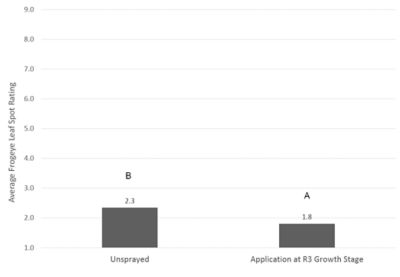5 MIN READ
Managing Frogeye Leaf Spot
February 3, 2022
TRIAL OBJECTIVE
Frogeye leaf spot (FLS) is caused by the fungus Cercospora sojina, which survives in soybean residue left on the soil surface and in infected soybean seeds. FLS has become a common, economically important disease in the hot, humid regions of the southeastern United States. Recently, incidences of FLS have become more common in northern regions of the United States where susceptible soybean products are commonly grown.
The objective of this study was to evaluate a system-based approach for FLS disease management supported by native resistance of germplasm and foliar fungicide.
Select soybean products with varying levels of resistance to FLS were evaluated under different fungicide management options.
RESEARCH SITE DETAILS
- This study was conducted at 14 locations in 7 states (IN, IL, KY, MS, MO, NC, OH) in fields with a history of FLS.
- Plots were planted in a strip trial
- One replication per location
- Experimental unit size ranged from 0.25 to 1 acre
- Alpha level of 0.1 was used for mean separation
- Fungicide treatments included:
- Untreated
- Application at R3 growth stage of Delaro® 325 SC fungicide at 8 oz/acre, Delaro® Complete Fungicide at 8 oz/acre or Stratego® YLD Fungicide at 4 oz/acre.
- Soybean products used were classified as susceptible (S), moderately susceptible (MS), moderately resistant/moderately susceptible (MR/MS), moderately resistant (MR), or resistant (R) to FLS.
- Plots were randomized within the trial.
- FLS disease ratings were taken at the R6 growth stage.
- 33 trial locations from 2020 and 2021 were planted for this study. Of these, 14 locations (42%) were included in the analysis below because they had slight to moderate frogeye leaf spot pressure.
UNDERSTANDING THE RESULTS





KEY LEARNINGS
There was a strong fungicide effect on FLS disease suppression. Yield results showed a significant advantage of nearly 3 bu/acre for soybeans sprayed with fungicide compared to the unsprayed treatment.
Genetics with enhanced resistance to FLS did not demonstrate a consistent yield advantage in this data set. However, soybean products with enhanced resistance had decreased FLS disease index ratings in the unsprayed plots.
- The Bayer fungicide products applied to soybeans at R3 growth stage consistently provided a yield advantage over the unsprayed treatment across soybean genetics in these trials in which FLS was present.
1007_R4